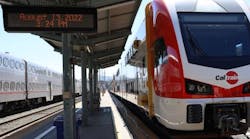The Caltrain Traction Power Substation in south San Francisco was energized with power for the first time from Pacific Gas and Electric Company (PG&E). The milestone achievement signifies major progress in expanding Caltrain’s ability to test and run electric trains along the corridor. This is the second traction power substation to be brought online following activation of Caltrain’s San Jose substation in August 2022.
Caltrain’s substation in south San Francisco is also one of two main traction power substations along the Caltrain corridor, in addition to the San Jose location, which was energized last August. Together, with eight other smaller facilities along the corridor, power substations provide, distribute and regulate electricity to the overhead wires, which will power Caltrain’s new high-performance electric trains.
The substation was constructed by Balfour Beatty and its industry partners. Caltrain, PG&E and Balfour Beatty’s work to complete the energization was substantial and needed to be safely conducted while maintaining reliable service to more than 20,000 customers also served by the existing infrastructure.
The infrastructure upgrades include:
- Construction of two, double-circuit 115 kV transmission connections from the East Grand Substation in south San Francisco and the FMC Substation in San Jose to Caltrain traction power stations in those communities.
- Rebuilt the East Grand and FMC substations that enabled PG&E to support Caltrain’s request for redundant transmission feeds.
- Additional upgrades to three PG&E and two third-party remote end substations.
“We’re so proud for the opportunity to work with Caltrain in delivering clean, modern, electrified transit service to San Jose, San Francisco and all our hometowns in between,” said Sandra Cullings, senior director, PG&E Projects and Construction. “I’m grateful for all the work by my PG&E coworkers who are playing a part in helping Caltrain eliminate diesel emissions, reduce traffic and improve public transit for the Bay Area.”
“We are proud to provide the infrastructure that powers progress on the Caltrain Electrification Project,” said Balfour Beatty U.S. Civils President Mark Konchar. “This milestone is attributed to the joint efforts of Balfour Beatty, PG&E and Caltrain’s ongoing commitment to collaboration. We look forward to continuing our vital work on the corridor, including the delivery of the Overhead Catenary System, to help our client provide a reliable, safe and sustainable commuter rail service in the area.”
As crews continue to install more poles and wire for the electrification system, Caltrain is embarking on a public outreach campaign to educate passengers, residents and businesses about best safety practices along the corridor. The agency has sent out mailers, hosted community meetings and embarked on social media campaigns to remind everyone that all overhead wires on Caltrain property should be assumed to be energized now.
The electrification of the Caltrain system will deliver major benefits to the communities that it serves. Electrification will reduce Caltrain’s greenhouse gas emissions and eliminate the particulate matter caused by the aging diesel engines. Engine noise created by the trains will also be reduced.
Service will become both more frequent and more comfortable as state-of-the-art electric trains replace the 30-year-old diesel fleet. Caltrain electrification has also created thousands of jobs locally and throughout the country, both to electrify the corridor and to assemble the new trains, which were debuted to the public in July and are available for a public tour in San Francisco on Sept. 23. The infrastructure that is being installed will be compatible with future high-speed rail on the corridor.
“Energization of the second traction power substation is a momentous milestone for the Caltrain Electrification Project and continues to keep us on track for launch of eElectrified service in fall of 2024,” said Michelle Bouchard, Caltrain executive director. “We want to thank the hundreds of people that have been involved in the work and coordination to get us to this moment. Soon, we be able to test electric trains along our entire corridor and we are excited to deliver a world-class system for the public.”





